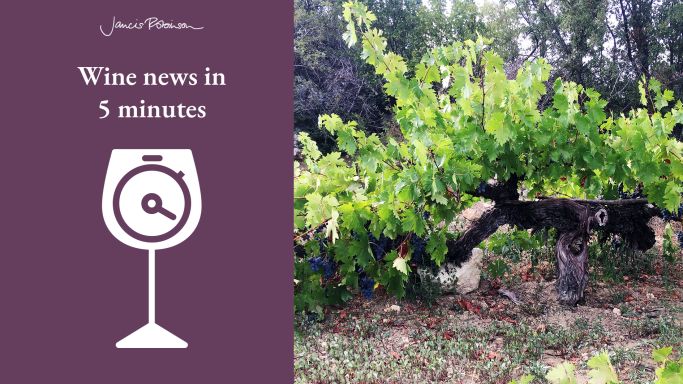Plus where to find the JancisRobinson.com team over the coming months, and congratulations to the latest winners of Golden Vines Wine Scholar Guild Scholarships.
Before I delve into the news today, a few updates on coming events.
Over the next few months I’ll be speaking at Women in Wine Oregon, Willamette – The Pinot Noir Auction and TEXSOM. Jancis will be at the FT Weekend Festival in London, the 50th Anniversary of the Dutch Wine Academy in Amsterdam and leading a six-day retreat on wine and philosophy to Greece. That last one is taking place at the end of October, and you can find details for all of those events at the Where to find us page on JancisRobinson.com.
Also, 17 June marked the deadline for our yearly writing competition. This year we received a record 211 entries. Our team of judges is reading through, and we’ll start publishing the best of them this coming Wednesday.
On to the news!
The Old Vine Registry's first birthday
What originally started as an Excel spreadsheet kept by Tam and Jancis was, with a donation from Jackson Family Wines and the expertise and management of Alder Yarrow, built into a full-blown online database cataloguing old-vine vineyards. In the year since the database launched, the number of vineyards catalogued has grown 50%, to 3,353 vineyards across 36 different countries. But, as Alder discusses on his blog, Vinography, this is a fraction of the world’s old-vine vineyards and so he writes, ‘with that in mind, we’ve set a BHAG (Big, Hairy, Audacious Goal) to register 10,000 vineyards in the next 3 years.’
To do this, the registry has launched a three-year competition called the Heritage Vine Hunt to encourage people to register as many old-vine vineyards as possible. Three winners will be declared at the end of the first year, three at the end of the second year, and one grand prize winner at the end of the third year. The grand prize will be an all-expenses-paid trip to an Old Vine Conference field trip somewhere in the world.
If you haven’t yet visited The Old Vine Registry, I highly recommend checking it out both to find out which producers work with old-vine vineyards and to add vineyards!
New standards for Appellation Marlborough Wines
First, and I apologise if this is review for some of you but please bear with me – an appellation is a legally defined and protected area that producers in the wine industry use to indicate where a wine is grown. There are thousands of them that go under different acronyms – AOP in France, DOC in Italy, AVA in the US, GI in New Zealand, etc. But critically, the standards that govern their usage are not the same. The ‘Old World’ – composed mostly of EU countries with a few countries in the Middle East – are notoriously strict with appellation standards and often regulate which varieties producers are allowed to grow, restrict use of irrigation, restrict yields, set minimum potential alcohol levels, restrict chaptalisation and acidification, and even have tasting panels to make sure that wine released with the appellation name meets the quality standard and flavour profile expected of that region. Meanwhile, the ‘New World’ is notoriously lax and usually draws a box around an area, says ‘make sure that a certain percentage (usually 85%) of the grapes are from here and then you can use the appellation name’.
Now whether or not one system is better than the other is a debate for another time, the point is, in sweeping generalisations, this is how it works.
But what this means is that if you make wine in Marlborough, New Zealand, and you crop your Sauvignon Blanc to 3 tons an acre and harvest at 12.5% alcohol and your neighbour crops 12 tons per acre and harvests at 9% potential alcohol then adds a bunch of sugar to get alcohol levels up to 12.5%, you can both bottle under the Marlborough Geographical Indication (GI).
So in 2018, the same year when the first GIs went into effect in New Zealand (yes, their appellation system is very young), a group of producers in Marlborough decided that they wanted more regulation in order to protect quality – they wanted 100% grapes from Marlborough, they wanted only vineyards registered sustainable, and they wanted a tasting panel. They created a certification called Appellation Marlborough Wine or AMW to enforce standards above and beyond the requirements of the government-regulated GI – standards more in line with the ‘Old World’ terminology of ‘appellation’. This privately regulated certification has its own trademarked logo that appears on wine labels.
On 11 June this organisation announced that they had further constricted the boundaries for AMW and had set a minimum potential alcohol level of 10.5%. Ontario’s VQA requires a tasting panel, Oregon’s Willamette Valley AVA opted for a higher minimum Pinot Noir percentage in varietally labelled wines, but I do not know of any ‘New World’ regional organisation that has (1) required registered sustainable vineyards for ‘appellation’ status, or (2) has enforced a minimum potential alcohol. So, if you are a Marlborough Sauvignon Blanc drinker, and quality and sustainability are important to you – it is worth seeking out wines that carry the AMW logo. Those that carry the generic GI are not required to adhere to the same standards.
Split between Ste Michelle Wine Estates and the Antinori family
Back in 1995 Ste Michelle Wine Estates (SMWE) and the Antinori family partnered to start an estate vineyard and winery in Washington’s Red Mountain AVA called Col Solare. Then, in 2007, when Warren Winiarski, a close friend of Marchese Piero Antinori, decided to sell the famous Stag’s Leap Wine Cellars, SMWE and the Antinoris partnered again to buy the property. But in the last two years the companies have parted ways.
In 2023, the Antinori family bought SMWE’s share in Stag’s Leap. On 21 June, it was announced that by the end of the month they will complete the purchase of SMWE’s share of Col Solare. This is very good news. Col Solare is, in my opinion, far safer under a 26-generation winemaking family than it was under a private-equity company (Sycamore Partners owns SMWE) that has been slashing vineyard contracts, cutting production and divesting assets.
Congratulations to 10 Golden Vines Wine Scholar Guild scholars
Finally, I’d like to extend congratulations from the Jancis Robinson.com team to the latest recipients of the Gérard Basset Foundation’s Golden Vines Wine Scholar Guild Scholarships. These awards give each of 10 applicants full enrolment in one of the WSG’s flagship scholar programmes (French, Spanish or Italian Wine Scholar) as well as WSG membership for one year. The recipients are all extraordinarily driven wine professionals. Congratulations to Deniz Bayram (UK), Denman Chan (Hong Kong), Eduardo Contreras (Mexico), Harnil Mathur (Hong Kong), Jounghwa Yi (Korea), Junqi Peng (USA), Karene Vilela (Brazil), Sammy Lam (USA), Valeria Tenison (France) and Xeniya Volosnikova (France).
This is a transcript of our weekly five-minute news broadcast, which you can watch below. You can also listen to it on The Wine News in 5 Podcast. If you have breaking news in your area, please email news@jancisrobinson.com. And if you enjoy this content and would like to see more like it, please subscribe to our site and our weekly newsletter.

